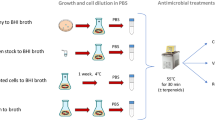Abstract
It was established that the exometabolites of Aranicola spp., isolated from beef, promoted the reversion of nonculturable forms of Listeria monocytogenes, isolated from the same product, into the proliferative state, influencing the expression of their biological properties, which was expressed by a change in the morphology and enzymatic properties of the colony, and also by an increase the hemolytic activity and a decrease in adhesiveness. It was noted that all changes in the biological properties of L. monocytogenes were phenotypic. Passage in trypticase-soy broth with further seeding of Listeria on yeast agar after the third passage led to a gradual change in the biological properties, until their complete recovery after the fifth passage on the sixth day of the study.
Similar content being viewed by others
References
Besnard, V., Federighi, M., and Cappelier, J.M., Evidence of viable but non-culturable state in Listeria monocytogenes by direct viable cut and CTC-DAPI double staining, J. Food Microbiol., 2000, vol. 17, no. 6, pp. 697–704.
Besnard, V., Federighi, M. and Cappelier, J.M., Development of a direct viable count procedure for the investigation of VBNC state in Listeria monocytogenes, J. Lett. Appl. Microbiol., 2002, vol. 31, pp. 77–81.
Brilis, V.I., Brilene, T.A., and Lentsner, Kh.P., Method of studying the adhesive process of microorganisms, Lab. Delo, 1996, no. 4, pp. 210–212.
Cappelier, M., Besnard, V., Roche, S., and Garrec, N., Avirulence of viable but non-culturable Listeria monocytogenes cells demonstrated by in vitro and in vivo models, J. Vet. Res., 2005, vol. 36, pp. 589–599.
Cappelier, M., Besnard, V., Roche, S., Velge, P., and Federighi, M., Avirulent viable but non-culturable cells of Listeria monocytogenes need the presence of an embryo to be recovered in egg yolk and regain virulence after recovery, J. Vet. Res., 2007, vol. 38, no. 4, pp. 573–583.
Efimochkina, N.R., Sheveleva, C.A., Nityaga, I.M., Tartakovskii, I.S., Ermolaeva, S.A., and Karpova, T.I., Modern approaches to the identification of Listeria monocytogenes during production control of fermented meat products, Vopr. Pitaniya, 2005, no. 2, pp. 39–45.
GOST R 51921-2002 Produkty pishchevye. Metody vydeleniya i opredeleniya bakterii Listeria monocytogenes (Food Products. Methods for Isolation and Detection of the Bacterium Listeria monocytogenes), Moscow: Minzdrav Rossii, 2002.
Liu, Y., Liu, W., and Liang, Z., Endophytic bacteria from Pinellia ternata, a new source of purine alkaloids and bacterial manure, Biol., 2015, vol. 53, pp. 1545–1548.
Metodicheskie ukazaniya MUK 4.2.1122-02. Organizatsiya kontrolya i metody vyyavleniya bakterii Listeria monocytogenes v pishchevykh produktakh (Organization of Control and Methods for Detecting the Bacterium Listeria monocytogenes in Food Products), Moscow: Minzdrav Rossii, 2002.
Mukamolova, G.V., Yanopolskaya, N.D., Kell, D.B., and Kaprelyants, A.S., On resuscitation from the dormant state of Micrococcus luteus, Antonie van Leeuwenhoek, 1998, vol. 73, pp. 237–243.
Oliver, J.D., The viable but nonculturable bacteria, J. Microbiol., 2005, vol. 2, pp. 93–100.
Pakhomov, Yu.D., Blinkova, L.P., and Stoyanova, L.G., The role of non-culturable forms of asporogenous bacteria in maintaining population homeostasis, Immunol. Allergol. Infektol., 2010, no. 4, pp. 57–66.
Paterson, J.S. and Cook, R., A method for the recovery of Pasteurella pseudotuberculosis from faeces, Pathol. Bacteriol., 1963, vol. 85, pp. 241–242.
Pitonzo, B.J., Amy, P.S., and Rudin, M., Resuscitation of microorganisms after gamma irradiation, J. Radiat. Res., 1999, vol. 152, no. 1, pp. 71–75.
Porter, J., Edwards, C., and Pickup, R.W., Rapid assessment of physiological status in Escherichia coli and Listeria monocytogenes using fluorescent probes, J. Appl. Bacteriol., 1995, vol. 4, pp. 399–408.
Pushkareva, V.I., Ermolaeva, S.A., and Litvin, V.Yu., Pathogenic Listeria and soil Protozoa: coupling of life cycles, Usp. Sovrem. Biol., 2008, vol. 128, no. 3, pp. 245–251.
Romanova, Yu.M., Chegaev, E.V., and Gintsburg, A.L., Nonculturable state in pathogenic bacteria: the known and possible factors of reversible process induction, Mol. Genet. Microbiol. Virusol., 1998, no. 3, pp. 3–8.
Shleeva, M.O., Mukamolova, G.V., and Telkov, M.V., Formation of nonculturable cells of Mycobacterium tuberculosis and their resuscitation, Microbiology (Moscow), 2003, vol. 72, no. 1, pp. 64–70.
Sorensen, T.S. and Attfield, P.V., Inducible gene expression by nonculturable bacteria in milk after pasteurization, J. Appl. Envir. Mocrobiol., 2002, vol. 68, no. 4, pp. 1988–1992.
Steinert, M., Emody, L., and Amann, R., Resuscitation of viable but nonculturable Legionella pneumophila, Philadelphia: JR32 by Acanthamoeba castellani, J. Appl. Envir. Microbiol., 1997, vol. 63, no. 5, pp. 2047–2053.
Tartakovskii, I.S., Maleev, V.V., and Ermolaeva, S.A., Listerii: rol’ v infektsionnoi patologii cheloveka i laboratornaya diagnostika (Listeria: Role in Human Infectious Pathology and Laboratory Diagnosis), Moscow: Meditsina dlya vsekh, 2002.
Vallenhofer-Schrumpf, S., Buresch, R., and Unger, G., Genegen technology for detection of Salmonella spp. and genus Listeria monocytogenes in chicken samples, J. Rapid Meth. Autom. Microbiol., 2006, vol. 14, no. 2, pp. 161–181.
Yaron, S. and Matthews, K., Reverse transcriptase–polymerase chain reaction assay for detection of viable Escherichia coli O157:H7: investigation of specific target genes, J. Appl. Microbiol., 2002, vol. 92, pp. 633–640.
Author information
Authors and Affiliations
Corresponding author
Additional information
Original Russian Text © L.S. Buzoleva, M.A. Sinel’nikova, 2017, published in Izvestiya Akademii Nauk, Seriya Biologicheskaya, 2017, No. 5, pp. 516–520.
Rights and permissions
About this article
Cite this article
Buzoleva, L.S., Sinel’nikova, M.A. Reversion of nonculturable forms of Listeria monocytogenes under the influence of exometabolites of Aranicola spp.. Biol Bull Russ Acad Sci 44, 501–505 (2017). https://doi.org/10.1134/S1062359017050053
Received:
Published:
Issue Date:
DOI: https://doi.org/10.1134/S1062359017050053




